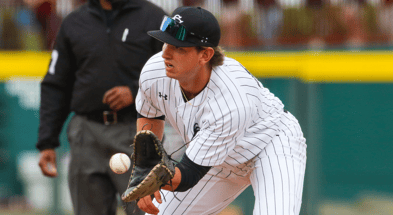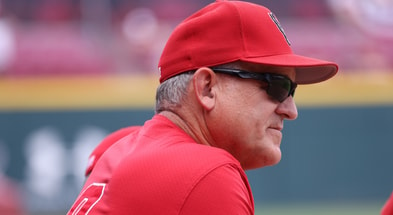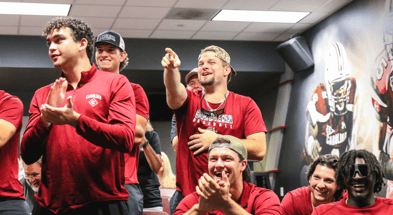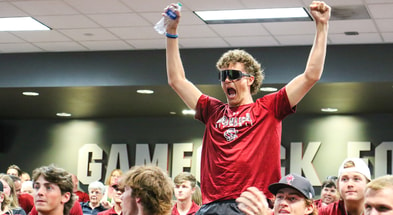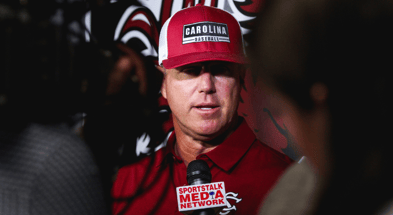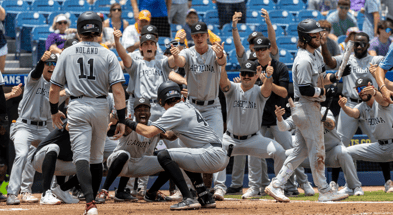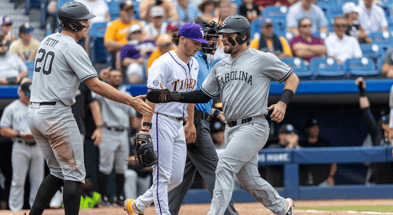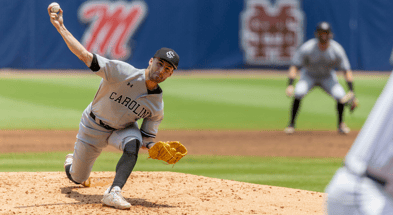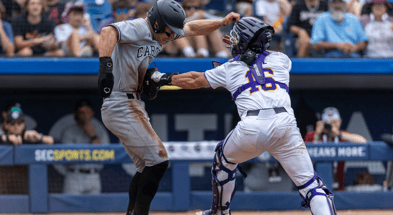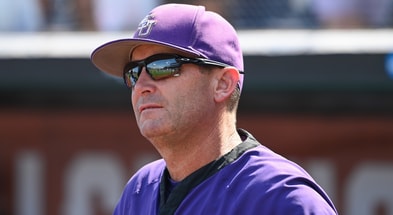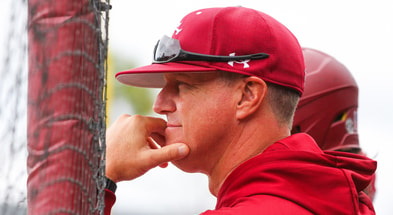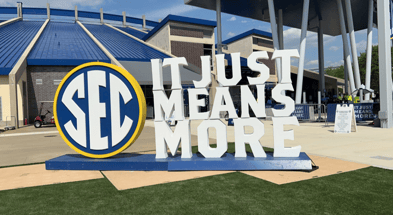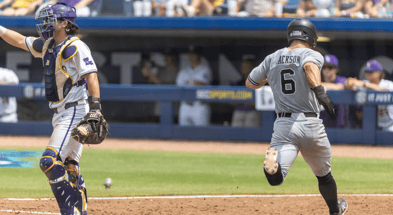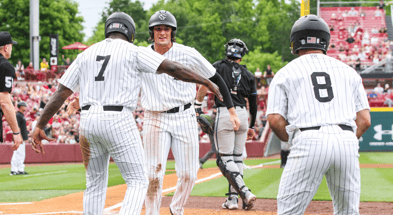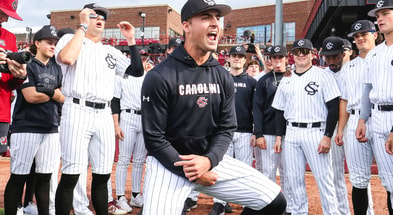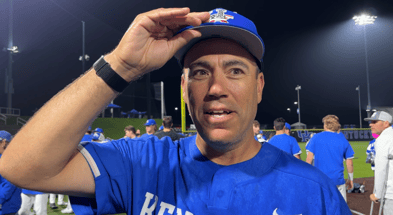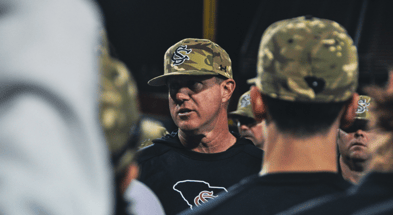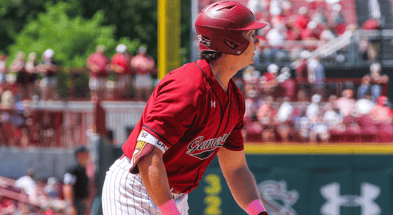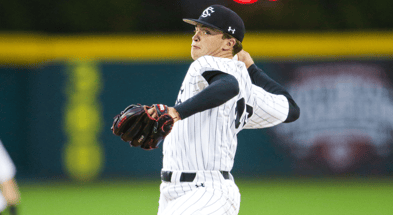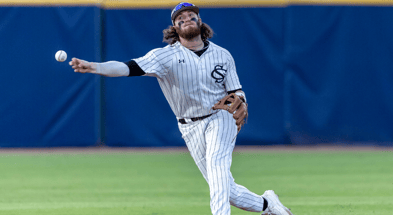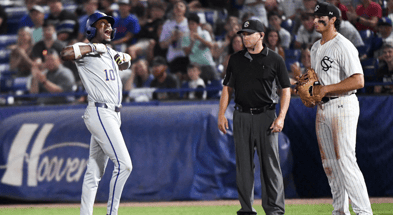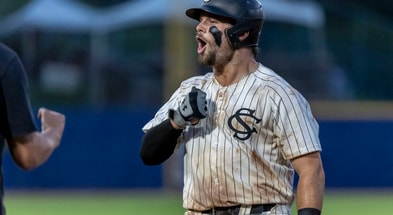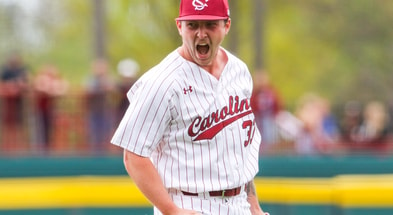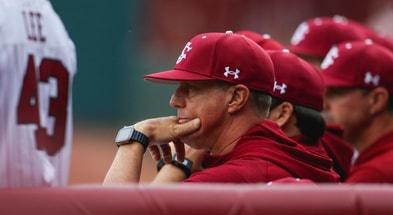1974: Renaissance on the diamond
Alan Piercy is the author of A Gamecock Odyssey: University of South Carolina Sports in the Independent Era (1971-1991). The following was originally published on Alan’s South By Southeast newsletter.
50 years ago this spring, Gamecock baseball earned its first-ever NCAA tournament bid
It’s almost lost amid the many program achievements enshrined within Founders Park. It sits up there on the right field wall amongst the dozens of year markers commemorating Carolina’s 34 (and counting) NCAA tournament appearances. It’s the first one and, in some ways, still the most important of the bunch.
Thirty-four NCAA Tournament appearances is not as many as some programs. Texas boasts 62, Florida State claims 59. Even in-state rival Clemson has 45 to its credit. But 34 is a lot more than most, and it’s more than enough to place the Gamecocks among the elite programs in college baseball over the last five decades. Besides that, it’s what the Gamecocks have accomplished in those 34 appearances that matter most.
Carolina has claimed 19 Regional championships during that span, earning 11 trips to the coveted grounds of Omaha’s College World Series. And when the Gamecocks make it to Omaha, they generally win big, claiming six championship game or series appearances, including two national championships in glorious back-to-back fashion in 2010 and 2011.
Imagine the frenzy around a Gamecock men’s basketball program that, in some golden alternate universe, could claim 34 NCAA Tournament appearances, 19 Sweet Sixteens, 11 Elite Eights, six Final Fours, and two national championships since the latter days of the Frank McGuire era, and you begin to grasp the understated excellence of Carolina baseball over the last half-century.
It all started in 1970 when then athletics director Paul Dietzel convinced Sumter native and former New York Yankees legend Bobby Richardson to take leadership of the program. After a few rebuilding years, Richardson’s program took off in 1974.
[GamecockCentral for $1: In-depth coverage and a great community]
Bobby Richardson brings the Major League to Columbia, fans follow
The 1974 Gamecocks rolled through February and March with an impressive 23-3 record before hosting an event in early April that only a former Yankees legend like Richardson could pull off.
When Richardson stepped away from Major League Baseball in 1970 to take over the Gamecock program, Yankees general manager Lee McPhail promised to bring the Bronx Bombers to Columbia to play the Gamecocks when Richardson was ready. By 1974, Richardson was eager to call in that favor. The Yankees were scheduled to travel back to New York along with the cross-town rival Mets after concluding spring training in Florida, so McPhail asked if Richardson could host both clubs, to which the coach happily agreed.
And so on Tuesday, April 2, the Gamecocks welcomed the Yankees and the Mets to the Rex Enright baseball diamond for a daylong event, featuring a home run contest between USC’s Hank Small, the Yankees’ Thurmon Munson, and the Mets’ Duffy Dyer, followed by two six-out contests pitting the Gamecocks versus both major league squads.
USC’s Small won the home run contest, and the Gamecocks defeated both the Yankees and Mets, thanks to some friendly pitching. Yankees pitching coach Whitey Ford pitched to his son, Eddie, a senior on Richardson’s Gamecock squad, who singled to right on the first pitch. The younger Ford said it was a straight fastball, “and I knew it was coming,” he grinned. “As a matter of fact, we talked about it before we took the field.”
The nightcap was a nine-inning exhibition between the Yankees and Mets under the lights.
Dick Huguley of the Columbia Record described the scenes as overflow crowds filled every seat in the then 2,000-seat stadium. They nestled on rooftops, peaked through dorm windows, and completely surrounded the outfield fence, some hanging over the top as they strained for a better view. Others poked peepholes in the green canvas that draped the fence. Homeowners along South Marion Street picked up extra cash charging for parking. Peanuts and candy sold out early at the concession stands. Fans turned treasure hunters, grappling for fly balls sent skyward by their Major League heroes.
Richardson said of the event, “It looked like rain, and Sarge Frye went over to the football stadium and got their big tarp – we didn’t have one – and brought it over and covered the whole field,” adding, “and the sun came out about five o’clock, we took the tarp off, and it was just a wonderful night for baseball. It couldn’t have been any better.”
Reflecting on the impact of the event on his program in the 1975 baseball media guide, Richardson noted,
“A lot of people who had never seen a college baseball team in action came out to see the major league players and saw that Carolina had a great college baseball program. The fans stuck with us after that.”
[Newsletters: Get breaking news and analysis from GamecockCentral]
Rarified air – the Gamecocks charge into NCAA play
Following the feel-good success of the Major League exhibition, Carolina hit a literal bump in the road, with two straight losses at fifth-ranked Georgia Southern in Statesboro. A disappointment, to be sure, but from there, the Gamecocks went on a tear, winning 21 of their next 22 games to close out the season an impressive 44-6, by far the best record in program history at the time.
It was good enough to earn Carolina its first-ever NCAA tournament bid.
The Gamecocks were slotted for the NCAA’s District III tournament in Starkville, Mississippi. Host school Mississippi State welcomed South Carolina, NC State, East Carolina, Miami (FL), Georgia Southern, and Vanderbilt to the post-season’s double-elimination opening round.
Heading into their first-ever NCAA tournament, the Gamecocks enjoyed their highest-ever No. 3 national ranking and boasted the best win-loss record in the South.
The Gamecocks left for Starkville by bus from the Roundhouse at 8 a.m., Tuesday, May 21. After stopping mid-day for lunch and a workout in Atlanta at Georgia Tech’s field, they continued on, arriving in Starkville around 8 p.m. The team enjoyed a rest day Wednesday as opening rounds began, and faced NC State at 3 p.m. on Thursday.
A smattering of Carolina faithful and friends of the program made the trip to Starkville, while most tuned in to “The Voice of the Gamecocks,” Bob Fulton covering play-by-play, while USC Sports Information Director Tom Price handled color commentary on WIS Radio.
South Carolina suffered no opening game jitters in their first-ever NCAA tournament matchup, as they dominated NC State 9-0 in the opener. Teddy Heffner, writing for The State, noted staff ace Earl Bass wasn’t as sharp as usual, but he was good enough to shut down the Wolfpack for six innings before reliever Allen Johnson “came on and hung goose eggs on the board the rest of the way.” Meanwhile, enough of USC’s “softly hit balls” found holes. Richardson, commenting on Bass’ performance postgame, agreed with Heffner’s assessment but noted, “To me, the mark of a good pitcher is getting people out with men on base, and that’s what Earl did.”
On Friday, Carolina starter Greg Ward turned in a gem, striking out 16 in a three-hitter versus East Carolina. The Gamecocks won handily, 5-1. Jeff Grantz, USC’s two-sport star and steady second-baseman, summed up the situation to reporters following the ECU game, “Anytime you win the first two games in a tournament like this, you have to be in good shape.”
Indeed, the Gamecocks were, but trouble awaited on Saturday in the form of the Miami Hurricanes. Miami’s ace Jerry Brust tossed a two-hit shutout as the Hurricanes blanked the Gamecocks 5-0, Carolina’s first shutout loss since an early April defeat at Georgia Southern. The Hurricanes played small ball, reaching base on three bunt hits in the first two innings against Carolina starter Tim Lewis, who was relieved early on. Miami finished with 14 hits against four Carolina pitchers in a long afternoon for the Gamecocks.
Carolina bounced back in an elimination game Saturday evening, scoring on a ninth-inning Jim Pankovits sacrifice fly to send Georgia Southern packing and stay alive in the tournament. Gamecock pitcher Raymond Lavigne moved to 5-0 on the season, tossing a complete game two-hitter.
The Saturday evening win left two teams remaining in Starkville – the Gamecocks, with one loss, and the undefeated Hurricanes. The teams looked to a Sunday rematch before rain forced a postponement until Monday, providing Gamecock ace Earl Bass (11-1) an extra day of rest. Carolina would have to win the 3pm Monday game to force a final and deciding game that evening.
Bass delivered again in game one, holding Miami to one run, while the Gamecocks erupted for a three-run eight-inning to win 3-1. The win left Carolina tantalizingly close to a trip to Omaha’s College World Series.
It was not to be, however, as Miami’s Brust was dominant again in the nightcap. Pitching on one day’s rest, the Hurricanes’ ace dominated Carolina hitters for the second time in three days, holding the Gamecocks hitless through seven innings. The Hurricanes prevailed 2-1, advancing to Omaha, where they would reach the championship game, ultimately losing to that year’s champion, Southern California.
“I think we have the makings of a real fine team”
USC finished 48-8 to complete a season of firsts for Gamecock Baseball. “I’ll be looking at the June (MLB) draft with a lot of interest,” Richardson told reporters. “It depends on who drafts them and when as to what a couple of my players will do. If they decide to turn pro, I’m with them all the way. But either way, I hope to be back next year,” the understated Richardson said before continuing, “I think we have the makings of a real fine team.”
Indeed, the two Gamecocks to whom Richardson alluded, Bass and Small, did come back for their senior season in 1975. The ‘75 Gamecocks avenged their 1974 counterparts by making it to Omaha, surging all the way to the first of the program’s six national championship appearances and solidifying Carolina’s swiftly-rising stock in the college baseball world.
The 1974 squad is not as well-remembered as that national runner-up squad of ‘75, or the team a couple of years later which repeated the feat in June Raines’ first season as head coach. But it is the team that put Gamecock baseball on the map and established a tradition of excellence still going strong some 50 years later.
A May 30, 1974 editorial in The State, titled New Pride of USC, opined:
Admittedly, there are some baseball fans whose interest vanished with the old Sally League and is revived only annually with the World Series. But we doubt there are many Columbians who are indifferent to the success of the Carolina Gamecocks this season.6
Coach Bobby Richardson and his team pumped some new life into the old American sport in this neighborhood with a hard run at the National Collegiate Athletic Association’s District III championship – and the Collegiate World Series – in Starkville, Miss.
The Gamecocks were imbued with talent, style and enthusiasm. USC’s newfound pride will be shared by many, and we expect it to be contagious. Coach Richardson hardly missed a stride after the last out, and headed into next year: “I don’t see any reason why we can’t be back.” Baseball fans – even the casual ones – should like the sound of that.
The commemorative markers on that right field wall at Founders Park are many. They all hold stories of players and coaches, and the mostly forgotten details of games played over 34 seasons across a half century. The 1974 marker is the same as the others in that regard.
The shadows of that Gamecock team did not darken the dugouts of Omaha’s Rosenblatt Stadium under a big Nebraska sky that June as future teams would. But that Gamecock squad was the first to taste the post-season, and in doing so, set a standard for future teams to follow and improve upon. For that alone, the boys of ‘74 will always hold a special place in program lore.
Notes and sources:
1) The College World Series moved to a best-of-three championship series format beginning with the 2001 season. Carolina reached the championship game in 1975, 1977, and 2000, losing those three matchups to Texas, Arizona State, and Texas, respectively. The Gamecocks then won championships in 2010 and 2011 (defeating UCLA and Florida, respectively), before making a third-consecutive trip to the championship series in 2012, coming up short against Arizona.
2) The Enright baseball diamond was part of a sprawling spring sports complex behind the old Roundhouse athletic offices, sitting along South Marion Street, between Rosewood Drive and Hayward Street. Gamecock baseball had played on this diamond since USC purchased and developed the property in the 1950s. In 1969, under the direction of Athletics Director Paul Dietzel, USC built a 2,000-seat stadium for baseball, along with coaches’ offices and training rooms as a part of the larger Roost athletics dormitory project. The original stadium was a spartan structure comprised of concrete with metal bleachers. Capacity was later expanded to 5,000 during the June Raines era, and in 1980, the university honored its longtime groundskeeper by renaming the facility “Sarge Frye Field.” Chairback seating was added, among other enhancements, during the Ray Tanner era. The facility served as the home of Gamecock Baseball through the 2008 season before moving to Carolina Stadium, later renamed Founders Park for its corporate naming sponsor.
3) Through the 1974 season, the NCAA employed district tournaments to determine the final eight teams who moved on to Omaha for the College World Series (CWS). Beginning with the 1975 season, the NCAA moved to a double-elimination regional tournament format. In 1999, the NCAA introduced the super regional round, in which the sixteen regional winners advance to eight super regional matchups, which in turn, determine the eight CWS participants.(source: https://en.wikipedia.org/wiki/NCAA_Division_I_baseball_tournament)
4) WIS was the radio home of Gamecock sports between 1954 and 2002. The station, 560 on the AM dial, began operations in 1930. The call letters were famously inspired by an advertising campaign launched via the South Carolina Natural Resources Commission, touting the Palmetto State’s iodine-rich soil. Iodine deficiency causes unsightly goiters around the neck and jawbone. The somewhat awkward campaign promoted vegetables grown in the iodine-rich soil of South Carolina, a natural remedy for such afflictions. WIS radio changed its call letters to WVOC (Voice of Columbia) in 1986, while its television counterpart, local NBC affiliate WIS-TV, retains the original call letters to this day. In 2002, WNKT (107.5 FM) became the radio host for Gamecock sports in the Midlands. (sources: South Carolina History Newsletter, #40; https://en.wikipedia.org/wiki/WVOC)
5) If, like me, you wondered if current USC Athletics Director Ray Tanner was a part of that ‘74 Wolfpack team, he was not. Tanner arrived a few years later from his native Smithfield, North Carolina, playing shortstop for Sammy Esposito’s Wolfpack from 1977-1980. Tanner was named an assistant at State upon his graduation, serving in that capacity until 1987, when he was named head coach upon Esposito’s retirement. Tanner compiled a 395-173-3 record as head coach at State over eight seasons. Ahead of the 1997 season, Tanner was named head coach at South Carolina, replacing June Raines after Raines’ 20-year head coaching tenure at USC. Tanner compiled a 738-316 (.700) record during the golden years of Gamecock baseball. From 2000 until his retirement from baseball after the 2012 season, South Carolina owned the best winning percentage in all of college baseball. (source: https://en.wikipedia.org/wiki/Ray_Tanner)
6) The “Sally League” noted in The State editorial is a reference to the South Atlantic League – an organization of Class A minor league baseball affiliates primarily based along the Atlantic Coast. Columbia had teams dating back to the formation of the Sally League in 1904, playing under various names, including the Skyscrapers, Gamecocks, Senators, Comers (or “Commies,” named for the city’s Commissioner form of government – this was before the anti-Communist hysteria of the post-World War II era), Reds, Gems, Mets, Bombers, and currently, the Fireflies. (Source: Mark Bryant, Baseball In Columbia (Charleston, SC: Arcadia Publishing, 2004)
